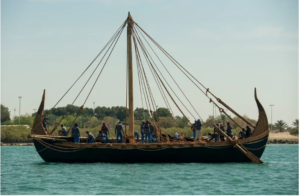The reconstructed Magan boat floating off the coast of Abu Dhabi Emily Harris / Zayed National Museum
This Bronze Age Ship Replica, Made From Reeds and Goat Hair, Just Sailed 50 Nautical Miles
A nearly 60-foot replica of a 4,000-year-old boat—complete with a sail made from goat hair—recently launched off the coast of Abu Dhabi, the capital of the United Arab Emirates.
According to a statement from Zayed University, the vessel passed numerous trials over two days at sea. It journeyed 50 nautical miles in the Arabian Gulf, reaching speeds of up to 5.6 knots (6.4 miles per hour).

A team of archaeologists and engineers designed the boat as part of a partnership between Zayed University, New York University Abu Dhabi and the Zayed National Museum. The replica is modeled after a “Magan” vessel, which once facilitated trade with destinations such as Mesopotamia and South Asia.
In the past, fragments of Magan boats have surfaced on the island of Umm an-Nar, off the coast of Abu Dhabi. Now, researchers want to use the replica vessel to shed new light on the lifestyle and craftsmanship of the Bronze Age people who lived in the region.
“I felt as though we were breathing life into history, bridging the gap between the distant past and the present,” says project manager Tayla Clelland in a statement, per CNN’s Ashley Strickland. “Seeing the Magan Boat sail on the water for the first time actually took my breath away and brought tears to my eyes.”
Thousands of years ago, “Magan” was the name of a region located in what is now the United Arab Emirates and parts of Oman. To reconstruct the boat, experts relied on a clay tablet from 2100 B.C.E. that detailed the necessary building materials.
“The clay tablet was discovered in the ancient site of Tello, southern Iraq,” Peter Magee, director of the Zayed National Museum, tells Newsweek’s Aristos Georgiou. “Written in Sumerian, one of the earliest known written languages, it depicts a shopping list of materials including four different types of wood, palm reeds, hides, goat hair, fish oil and bitumen.”
The researchers constructed the boat using traditional Bronze Age tools and techniques. To create the outer hull, they gathered 15 tons of locally sourced reeds. They then soaked the reeds, stripped away their leaves, and crushed and tied them together with date palm fiber rope. Finally, the builders attached the reed bundles to the internal wooden frames and coated them in bitumen, a viscous liquid made from crude oil that helped waterproof the vessel.
“We gained a much deeper knowledge of the materials used to build such boats to better understand the strengths and weaknesses of these revolutionary craft,” says Eric Staples, a maritime historian at Zayed University, per CNN. “We also gained a much deeper appreciation for the ingenuity and courage of the ancient shipbuilders and seafarers of the Bronze Age.”
Once the ship was complete, there was no guarantee that it would stay afloat at sea. CNN reports that 20 people worked to lift the sail and rigging; they, like the Bronze Age builders, did not use pulleys.
“When we first towed the boat out from the jetty, we were very careful,” says champion Emirati sailor Marwan Abdullah Al-Marzouqi, who was one of the boat’s captains, in the statement. “I was very aware it was made from only reeds, ropes and wood—there are no nails, no screws, no metal at all—and I was afraid of damaging her.”
However, once the crew got out on the water, those fears were put to rest. “I soon realized that this was a strong boat,” he says. “I was surprised by how this big boat, weighed down with a heavy ballast, moved so smoothly on the sea.”
According to the researchers, the project is the largest replica of its kind ever attempted.
“Appreciating the maritime history of the Arabian Gulf is key to understanding the importance of Abu Dhabi in the ancient world,” says Mohamed Khalifa Al Mubarak, chairman of Abu Dhabi’s culture and tourism department, in the statement. “From ancient shipbuilders to today’s archaeologists, the launch of this impressive Magan boat reconstruction represents thousands of years of Emirati innovation and exploration, and a long legacy of forging regional and international connections.”
The replica Magan boat will eventually travel to the Zayed National Museum on Saadiyat Island, where it will be on public display. The museum is currently under construction and is scheduled to open in 2025.
